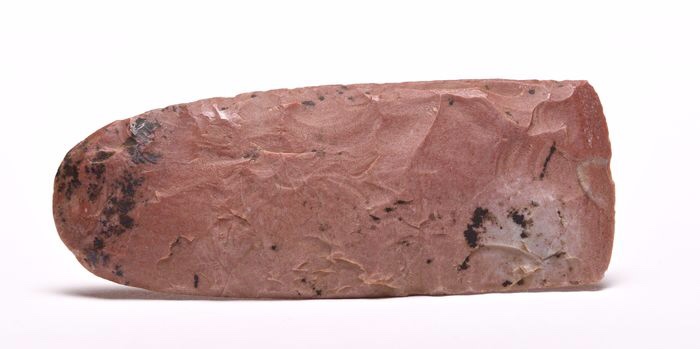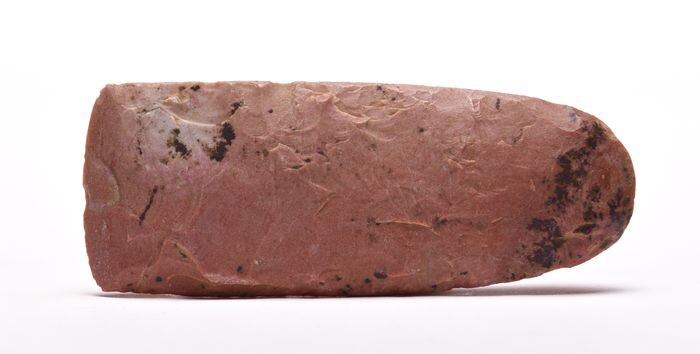The Neolithic British Isles refers to the period of British, Irish and Manx history that spanned from c. 4000 to c. 2,500 BCE. The final part of the Stone Age in the British Isles, it was a part of the greater Neolithic, or “New Stone Age“, across Europe.
Humans first settled down and began farming. They continued to make tools and weapons from flint. Some tools stayed the same from earlier periods in history, such as scrapers for preparing hides.
But the Neolithic also saw the introduction of new stone tool. First there was a movement away from using microliths to make spears and arrows as composite weapons and instead the universal adoption of flint arrow heads.
Neolithic tools were often retouched all over, by pressure flaking, giving a characteristic appearance and were often laboriously polished, again giving them a distinctive look.
Pottery also developed in this period and there are examples of Neolithic Pottery recorded in this collection

Neolithic Blood Red Flint Axe 
Neolithic Blood Red Flint Axe 
Neolithic Blood Red Flint Axe 
Neolithic Blood Red Flint Axe 
Neolithic Blood Red Flint Axe 
Neolithic Blood Red Flint Axe
Neolithic Blood Red Flint Axe
Provenance – Found near the River Ter Valley, Chelmsford, Essex
Description – Blood Red Flint Axe. Red Flint is not natural to Britain but found in Doggerland and the North Sea Island Heligoland.
Video below – Showcases this find
Size – 10cm x 4cm
Weight – 84g
Age / Period – Neolithic 4000 BCE – 2500 BCE
Blood Red Flint
These stones originate from Doggerland which has long since disappeared beneath the waves. It was about 11,000 years ago that this land bridge between England and Europe disappeared.
Doggerland was home to Mesolithic peoples, it was lush and fertile but low lying and so prone to flooding and marshland.
The final destruction of Doggerland came in the form of a huge Tsunami that drowned this area of the North Sea and the English Channel.
Turning England into the island that it is today.
During the Neolithic period Blood Red Flint became an exotic commodity and Neolithic peoples were willing to travel vast distances in search of it and they were willing to put their lives at risk to obtain this red rock – maybe it was a distant reminder of the lost paradise of Doggerland.
The only place in Europe it is now found is the North Sea island of Heliogland
This red silex was a rare commodity in prehistoric days.
Here on this island and the long lost land bridge these rust-red stones: originated in dead-waters which sloshed there around 90 million years ago: in the oxygen-deprived water, a lot of iron-oxyd was deposited – coloring red the silica, from which the silex (flint) was later formed.
Humans always seem to have had a passion for beautiful stones. And the red stones of Helgoland appear to have been much in demand for all kinds of tools and weaponry: sickles, axes, daggers, scrapers and much more.
If you want to reach the island from land, you must cross a considerable stretch of open water – without any sight-contact with land features. „How humans could have done this in the Neolithic, is incredible.
Blood Red Flint tools, flakes and cores have been found in various location across Europe, here in England they have been found in the New Forest, Hampshire and here in East anglia where Yhana and I continue our journey and understanding of the Prehistoric era.
Our treasure hunting is not just about finding items off interest, as the moment you take them out of context from the area found you lose so much knowledge of the people’s that lived, made and worked them.
So this video focuses on that illusive Blood Red Flint, as even the left over fragments discarded 1000’s of years ago are just as important as the tools them selves.
They tell us, that our ancient Neolithic forebears travelled for months at a time and across vast seas to obtain a raw material that could be found in no other place in its natural raw form.
They brought them here to the site we are searching and for first time in 4,500 years they are being collected, recorded and respected.


